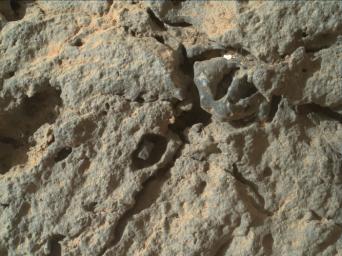
|
Detail in “Point Lake” Outcrop
- Click the image above for a larger view
- Full-Res JPEG (1584 x 1184) (348.5 kB)
- Full-Res TIFF (1584 x 1184) (5.6 MB)
Caption:
The Mars Hand Lens Imager (MAHLI) on the arm of NASA's Mars rover Curiosity was positioned about 4 inches (10 centimeters) from the surface of the "Point Lake" outcrop when it took this image of a portion of the outcrop's steep face. This close-up view and others from MAHLI on the same Martian day -- Sol 303 of the mission (June 13, 2013) -- show that many holes in the rock are occupied by what appears to be material different from that of the main rock itself. Specifically, the material in the holes seems to be finer-grained, slightly darker, and slightly more resistant to weathering. In many instances, there is a moat of sorts between the more resistant interior material and the main Point Lake rock.
In this image, the larger hole containing a darker inclusion with a fleck of bright material in the moat is roughly 1 inch (2.5 centimeters) in diameter.
Curiosity's science team chose to approach Point Lake with the rover in June 2013 to get a closer look after earlier imaging of Point Lake (such as at PIA17071 ) left uncertainty about whether this outcrop is igneous or sedimentary.
A closer look still leaves room for interpretation. The material in the holes observed with MAHLI could be pebbles that blew into pre-existing holes, but it seems unlikely that the same type of pebble would blow into every hole. They might be pebbles that were part of the rock all along, as would be expected if Point Lake is sandstone with a few coarser pebbles (and therefore supporting the sedimentary interpretation). If Point Lake is igneous, the material in the holes might be individual, larger crystals within an otherwise finer-crystalline rock. Such crystals are called phenocrysts, and indicate that they got a head start on cooling before the rest of the rock was erupted onto the surface. Finally, the material in the holes could be secondary -- having been deposited at a later time in pre-existing holes of the rock from percolating fluids or gases. This last scenario could fit either the sedimentary or igneous interpretation, without favoring one over the other.
Background Info:
Malin Space Science Systems, San Diego, developed, built and operates MAHLI. NASA's Jet Propulsion Laboratory, Pasadena, Calif., manages the Mars Science Laboratory Project and the mission's Curiosity rover for NASA's Science Mission Directorate in Washington. The rover was designed and assembled at JPL, a division of the California Institute of Technology in Pasadena.
More information about Curiosity is online at http://www.nasa.gov/msl and http://mars.jpl.nasa.gov/msl/ .
Cataloging Keywords:
| Name | Value | Additional Values |
|---|---|---|
| Target | Mars | |
| System | ||
| Target Type | Planet | |
| Mission | Mars Science Laboratory (MSL) | |
| Instrument Host | Curiosity Rover | |
| Host Type | Rover | |
| Instrument | Mars Hand Lens Imager (MAHLI) | |
| Detector | ||
| Extra Keywords | Color | |
| Acquisition Date | ||
| Release Date | 2013-06-25 | |
| Date in Caption | 2013-06-13 | |
| Image Credit | NASA/JPL-Caltech/MSSS | |
| Source | photojournal.jpl.nasa.gov/catalog/PIA17267 | |
| Identifier | PIA17267 | |
